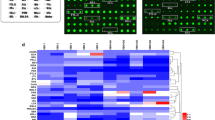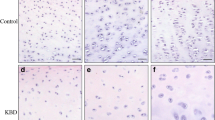Abstract
To investigate selenium (Se) concentrations in serum of patients with rheumatoid arthritis (RA), osteoarthritis (OA), and Kashin–Beck disease (KBD), together with the effect of Se supplement (chondroitin sulfate [CS] nano-Se [SeCS]) on CS structure–modifying sulfotransferases in KBD chondrocyte. Fifty serum samples from each group with aged-matched (40–60 years), normal control (N), RA, OA, and KBD (25 males and females, respectively) were collected to determine Se concentrations. Furthermore, the KBD chondrocytes were divided into two groups following the intervention for 24 h: (a) non-treated KBD group and (b) SeCS-treated KBD group (100 ng/mL SeCS). The ultrastructural changes in chondrocytes were observed by transmission electron microscopy (TEM). Live/dead staining was used to observe cell viability. The expression of CS-modifying sulfotransferases including carbohydrate sulfotransferase 12, 13, and 15 (CHST-12, CHST-13, and CHST-15, respectively), and uronyl 2-O-sulfotransferase (UST) were examined by quantitative real-time polymerase chain reaction and western blotting analysis after SeCS intervention. The Se concentrations in serum of KBD, OA, and RA patients were lower than those in control. In OA, RA, and control, Se concentrations were higher in male than in female, while it is opposite in KBD. In the cell experiment, cell survival rate and mitochondrial density were increased in SeCS-treated KBD groups. Expressions of CHST-15, or CHST-12, and CHST-15 on the mRNA or protein level were significantly increased. Expression of UST slightly increased on the mRNA level, but no change was visible on the protein level. Se deficiency in serum of RA, OA, and KBD was observed. SeCS supplemented in KBD chondrocytes improved their survival rate, ameliorated their ultrastructure, and increased the expression of CS structure–modifying sulfotransferases.





Similar content being viewed by others
References
Wrobel JK, Power R, Toborek M (2015) Biological activity of selenium: revisited. IUBMB Life 68:97–105
Hatfield DL, Tsuji PA, Carlson BA, Gladyshev VN (2014) Selenium and selenocysteine: roles in cancer, health, and development. Trends Biochem Sci 39:112–120
Yazar M, Sarban S, Kocyigit A, Isikan UE (2005) Synovial fluid and plasma selenium, copper, zinc, and iron concentrations in patients with rheumatoid arthritis and osteoarthritis. Biol Trace Elem Res 106:123–132
Önal S, Nazıroğlu M, Çolak M, Bulut V, Flores-Arce MF (2011) Effects of different medical treatments on serum copper, selenium and zinc levels in patients with rheumatoid arthritis. Biol Trace Elem Res 142:447–455
Peretz A, Neve J, Vertongen F, Famaey JP, Molle L (1987) Selenium status in relation to clinical variables and corticosteroid treatment in rheumatoid arthritis. J Rheumatol 14:1104–1107
Yu N, Han F, Lin X, Tang C, Ye J, Cai X (2015) The association between serum selenium levels with rheumatoid arthritis. Biol Trace Elem Res 172:1–7
Shi XW, Guo X, Ren FL, Li J, Wu XM (2010) The effect of short tandem repeat loci and low selenium levels on endemic osteoarthritis in China. J Bone Joint Surg Am 92:72–80
Yu FF, Zhang YX, Zhang LH, Li WR, Guo X, Lammi MJ (2016) Identified molecular mechanism of interaction between environmental risk factors and differential expression genes in cartilage of Kashin–Beck disease. Medicine 95:e5669
Lei R, Jiang N, Zhang Q, Hu S, Dennis BS, He S, Guo X (2016) Prevalence of selenium, T-2 toxin, and deoxynivalenol in Kashin-Beck disease areas in Qinghai Province, Northwest China. Biol Trace Elem Res 171:34–40
Guo Y, Li H, Yang L, Li Y, Wei B, Wang W, Gong H, Guo M, Nima C, Zhao S, Wang J (2017) Trace element levels in scalp hair of school children in Shigatse, Tibet, an endemic area for Kaschin-Beck disease (KBD). Biol Trace Elem Res 180:15–22
Guan F, Li S, Wang ZL, Yang H, Xue S, Wang W, Song D, Zhou X, Zhou W, Chen JH, Caterson B, Hughes C (2013) Histopathology of chondronecrosis development in knee articular cartilage in a rat model of Kashin–Beck disease using T-2 toxin and selenium deficiency conditions. Rheumatol Int 33:157–166
Liu JT, Guo X, Ma WJ, Zhang YG, Xu P, Yao JF, Bai YD (2010) Mitochondrial function is altered in articular chondrocytes of an endemic osteoarthritis, Kashin-Beck disease. Osteoarthr Cartil 18:1218–1226
Li S, Cao J, Caterson B, Hughes CE (2012) Proteoglycan metabolism, cell death and Kashin-Beck disease. Glycoconj J 29:241–248
Han J, Li D, Qu C, Wang D, Wang L, Guo X, Lammi MJ (2017) Altered expression of chondroitin sulfate structure modifying sulfotransferases in the articular cartilage from adult osteoarthritis and Kashin-Beck disease. Osteoarthr Cartil 25:1372–1375
Yan J, Zheng Y, Min Z, Min Z, Ning Q, Lu S (2013) Selenium effect on selenoprotein transcriptome in chondrocytes. Biometals 26:285–296
Dai X, Song R, Xiong Y (2017) The expression of ERK and JNK in patients with an endemic osteochondropathy, Kashin-Beck disease. Exp Cell Res 359:337–341
Djerbal L, Lortat-Jacob H, Kwok J (2017) Chondroitin sulfates and their binding molecules in the central nervous system. Glycoconj J 34:1–14
Han J, Guo X, Wu C, Li C, He S, Duan C, Ning Y (2013) Nano-Se-chondroitin sulfate inhibits T-2 toxin-induced apoptosis of cultured chondrocytes from patients with Kashin-Beck disease. Journal of Southern Medical University 33:225–229
Yue J, Yang M, Yi S, Dong B, Li W, Yang Z, Lu J, Zhang R, Yong J (2012) Chondroitin sulfate and/or glucosamine hydrochloride for Kashin-Beck disease: a cluster-randomized, placebo-controlled study. Osteoarthr Cartil 20:622–629
Han J, Guo X, Lei Y, Dennis BS, Wu S, Wu C (2012) Synthesis and characterization of selenium-chondroitin sulfate nanoparticles. Carbohydr Polym 90:122–126
Cao CX, Zhang YG, Wu SX, Younas MI, Guo X (2013) Association of clinical features of bone and joint lesions between children and parents with Kashin-Beck disease in Northwest China. Clin Rheumatol 32:1309–1316
Ropes MW, Bennett GA, Cobb S, Jacox R, Jessar RA (1958) 1958 Revision of diagnostic criteria for rheumatoid arthritis. Arthritis Rheum 9:175–176
Forestier R, Francon A, Briole V, Genty MC, Chevalier X, Richette P (2011) Diagnostic criteria for generalized osteoarthritis: a preliminary study in a population with knee osteoarthritis. Joint Bone Spine 7:424–426
Wan J, Zhang M, Adhikari B (2018) Advances in selenium-enriched foods: from the farm to the fork. Trends Food Sci Technol 76:1–5
Han J, Liang H, Yi J, Tan W, He S, Wu X, Shi X, Ma J, Guo X (2016) Selenium deficiency induced damages and altered expressions of metalloproteinases and their inhibitors (MMP1/3, TIMP1/3) in the kidneys of growing rats. J Trace Elem Med Biol 34:11–34
Han J, Liang H, Yi J, Tan W, He S, Wang S, Li F, Wu X, Ma J, Shi X, Guo X, Bai C (2017) Long-term selenium-deficient diet induces liver damage by altering hepatocyte ultrastructure and MMP1/3 and TIMP1/3 expression in growing rats. Biol Trace Elem Res 175:1–9
Zhou X, Smith AM, Failla ML, Yu Z, Hill KE (2012) Estrogen status alters tissue distribution and metabolism of selenium in female rats. J Nutr Biochem 23:532–538
Ha EJ, Smith AM (2003) Plasma selenium and plasma and erythrocyte glutathione peroxidase activity increase with estrogen during the menstrual cycle. J Am Coll Nutr 22:43–51
Moon HJ, Ko WK, Han SW, Kim DS, Hwang YS, Park HK, Kwon IK (2012) Antioxidants, like coenzyme Q10, selenite, and curcumin, inhibited osteoclast differentiation by suppressing reactive oxygen species generation. Biochem Bioph Res Co 418:247–253
Chen Z, Gu D, Zhou M, Shi H, Yan S, Cai Y (2016) Regulatory role of miR-125a/b in the suppression by selenium of cadmium-induced apoptosis via the mitochondrial pathway in LLC-PK1 cells. Chem Biol Interact 243:35–44
Jin X, Xu Z, Zhao X, Chen M, Xu S (2017) The antagonistic effect of selenium on lead-induced apoptosis via mitochondrial dynamics pathway in the chicken kidney. Chemosphere 180:259–266
Izumikawa T, Dejima K, Watamoto Y, Nomura KH, Kanaki N, Rikitake M, Tou M, Murata D, Yanagita E, Kano A, Mitani S, Nomura K, Kitagawa H (2016) Chondroitin 4-O-sulfotransferase is indispensable for sulfation of chondroitin and plays an important role in maintaining normal life span and oxidative stress responses in nematodes. J Biol Chem 291:23294–23304
Izumikawa T, Koike T, Kitagawa H (2012) Chondroitin 4-O-sulfotransferase-2 regulates the number of chondroitin sulfate chains initiated by chondroitin N-acetylgalactosaminyltransferase-1. Biochem J 441:697–705
Kang HG, Evers MR, Xia G, Baenziger JU, Schachner M (2002) Molecular cloning and characterization of chondroitin-4-O-sulfotransferase-3. A novel member of the HNK-1 family of sulfotransferases. J Biol Chem 277:34766–34772
Ohtake S, Ito Y, Fukuta M, Habuchi O (2001) Human N-acetylgalactosamine 4-sulfate 6-O-sulfotransferase cDNA is related to human B cell recombination activating gene-associated gene. J Biol Chem 276:43894–43900
Ito Y, Habuchi O (2000) Purification and characterization of N-acetylgalactosamine 4-sulfate 6-O-sulfotransferase from the squid cartilage. J Biol Chem 275:34728–34736
Li JL, Li HX, Li S, Gao XJ, Xu SW, Tang ZX (2012) Effects of Selenoprotein W gene expression by selenium involves regulation of mRNA stability in chicken embryos neurons. Biometals 25:459–468
Ohtake S, Kimata K, Habuchi O (2005) Recognition of sulfation pattern of chondroitin sulfate by uronosyl 2-O-sulfotransferase. J Biol Chem 280:39115–39123
Guo Y, Zhou Y, Yan S, Qu CJ, Wang LY, Guo X, Han J (2019) Decreased expression of CHST-12, CHST-13, and UST in the proximal interphalangeal joint cartilage of school-age children with Kashin–Beck disease: an endemic osteoarthritis in China caused by selenium deficiency. Biol Trace Elem Res:1–10
Luo M, Chen J, Li S, Sun H, Zhang Z, Fu Q, Li J, Wang J, Hughes CE, Caterson B, Cao J (2014) Changes in the metabolism of chondroitin sulfate glycosaminoglycans in articular cartilage from patients with Kashin-Beck disease. Osteoarthr Cartil 22:986–995
Huang Z, Rose AH, Hoffmann PR (2012) The role of selenium in inflammation and immunity: from molecular mechanisms to therapeutic opportunities. Antioxid Redox Signal 16:705–743
Ruffell B, Poon GF, Lee SS, Brown KL, Tjew SL, Cooper J, Johnson P (2011) Differential use of chondroitin sulfate to regulate hyaluronan binding by receptor CD44 in inflammatory and interleukin 4-activated macrophages. J Biol Chem 286:19179–19190
Acknowledgments
We thank the staffs of the Endemic Disease Control Center in Linyou County for their help of serum collection.
Funding Resource
This work was supported by the Shenzhen Science and Technology Project (201771796), and National Natural Scientific Foundation of China (81402639, 81620108026).
Author information
Authors and Affiliations
Corresponding author
Ethics declarations
This study was approved by the Human Ethics Committee of the Xi’an Jiaotong University. All subjects provided a written informed consent for participation in the study.
Conflict of Interest
The authors declare that they have no conflict of interest.
Additional information
Publisher’s Note
Springer Nature remains neutral with regard to jurisdictional claims in published maps and institutional affiliations.
Rights and permissions
About this article
Cite this article
Wang, L., Yin, J., Yang, B. et al. Serious Selenium Deficiency in the Serum of Patients with Kashin–Beck Disease and the Effect of Nano-Selenium on Their Chondrocytes. Biol Trace Elem Res 194, 96–104 (2020). https://doi.org/10.1007/s12011-019-01759-7
Received:
Accepted:
Published:
Issue Date:
DOI: https://doi.org/10.1007/s12011-019-01759-7




